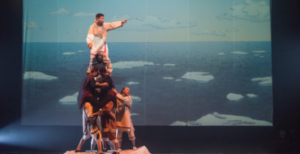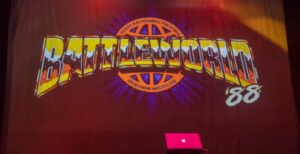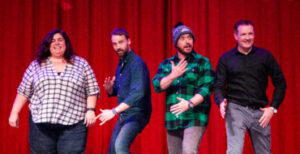As the audience expectantly murmurs their way into their seats, Pieter Ampe is on his back on the hard floor, legs straight up in the air, feet flattened out above him to create a makeshift throne on which Guilherme Garrido supports his full weight, observing the audience in cheerful comfort. It’s many, many minutes before the audience is seated, and by the time Guilherme begins to talk, Pieter’s face is already red with exertion.
Guilherme’s story of the duo’s first days in Vancouver is so casually engaging that for a few moments, we forget that each rambling joke about the Elbow Room or Steve Nash adds torturous seconds to Pieter’s unpleasant situation. Gradually, Pieter becomes unsettled, then insistent, tugging pitifully at the bottom of Guilherme’s foot to get his attention. As if in misguided recompense, Guilherme begins to introduce his partner with a series of playful and stupid puns (“Someone who really brings me up when I am feeling down”). Once he has given us Pieter’s name, though, instead of disburdening his parter, Guilherme leads the audience in yelling a series of increasingly teasing greetings to the now frantic man on the floor. By the time Guilherme relents and hops down for the show to begin, we already have the sense that Pieter has been pushed to his limits, abused physically and emotionally.
Throughout, of course, the question remains – why didn’t Pieter just let Guilherme fall?
Through the next fifty or so minutes, a childishly rough mess of ecstatic imagination and unpredictable violence, this question remains. There is more abuse than playfulness in Still Standing You, more domination than equality. But Pieter and Guilherme are locked in a struggle that we sense neither would choose to walk away from.
In sequences highly distinct from most contemporary dance, Guilherme and Pieter present what feels like the relationship between two young boys. The desire for power and the innocence of curiosity play equal and seemingly interchangeable parts in the men’s motives. Some of the violence they do to each other is malicious; some aims not to hurt, but to dominate; some is the unexpected collateral of a new physical exploration. And it’s the audience, if anyone, that is asked to pass judgement; there is no sense of understanding from the dancers of what their actions might mean in a moral or sexual context. We are watching humans at play, and if we are to learn lessons from it, we must construct them ourselves.
The personalities on-stage are distinct. Guilherme is playful and flamboyant, an incorrigible show-off whose overt behaviour belies an underlying maliciousness and a strangely concordant vulnerability. Pieter is primal and guileless, stamping around the stage and roaring at the audience with a sweetly un-intimidating largeness. He is the George Milton, perhaps, to Guilherme’s Lennie Small.
The choreography constantly subverts and destroys itself. There are feats of grace and athleticism, but the two dancers are just as likely in a moment to embody a small boy’s imagination of fierce dinosaurs and unstoppable robots; they soar one moment and kung-fu-fight each other the next. Violence is unavoidable, central. We thrill when they struggle equally, and cringe when Pieter stamps Guilherme against the ground, or when Guilherme spits repeatedly in Pieter’s face – they are our gladiators. Physically and emotionally, they abuse each other for us. And again we wonder: why do these people suffer so much from each other?
The poignant later sequences begin to answer this question for us. Through the first half of the performance, the audience roars with laughter or gasps with amused distaste, but in the second half, they sit quietly. Here we begin to see the other side of Pieter and Guilherme’s relationship – that with the capacity to hurt and be hurt deeply also grows the capacity to connect and to care. As the warriors beat each other down, we begin to see the struggle not as one for domination, but as a struggle for balance between two extremely different people. The piece gives us a rollicking show of visceral, and often very funny, brutality, but it also reminds us of the brutality that we accept in our own lives…and perhaps asks, “Why?”
I had the pleasure of sitting next to a duo who appeared to be the only audience members who absolutely hated the show. As we applauded at the end of the performance, the two men looked at each other, glared, then loudly booed. Cathartic, unusual, and polarizing – if that’s not a good sell for a show, I don’t know what is.









